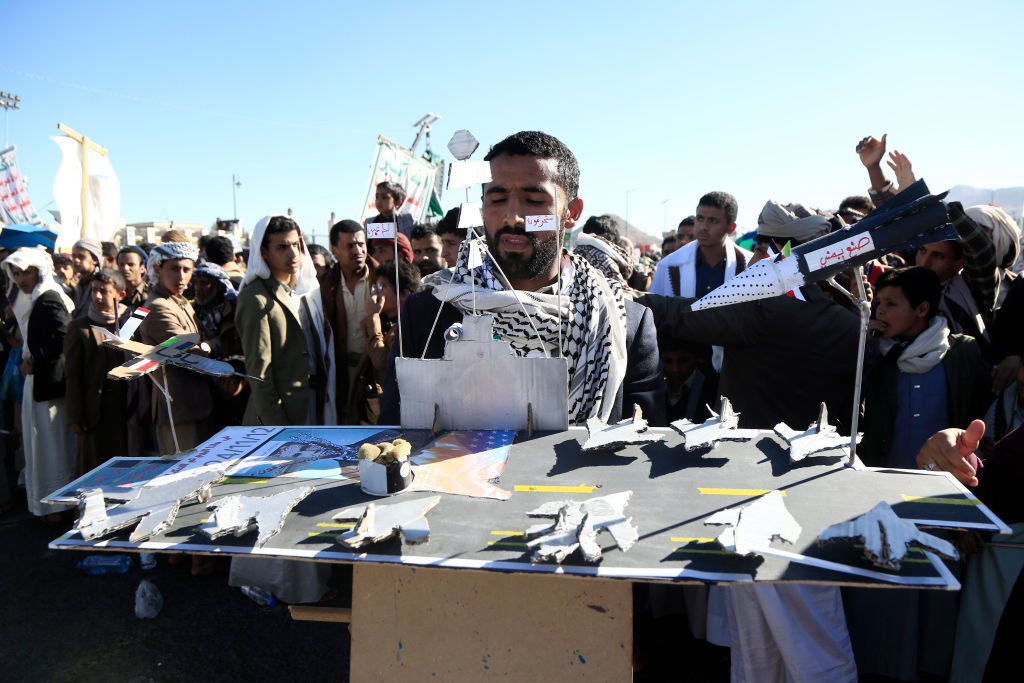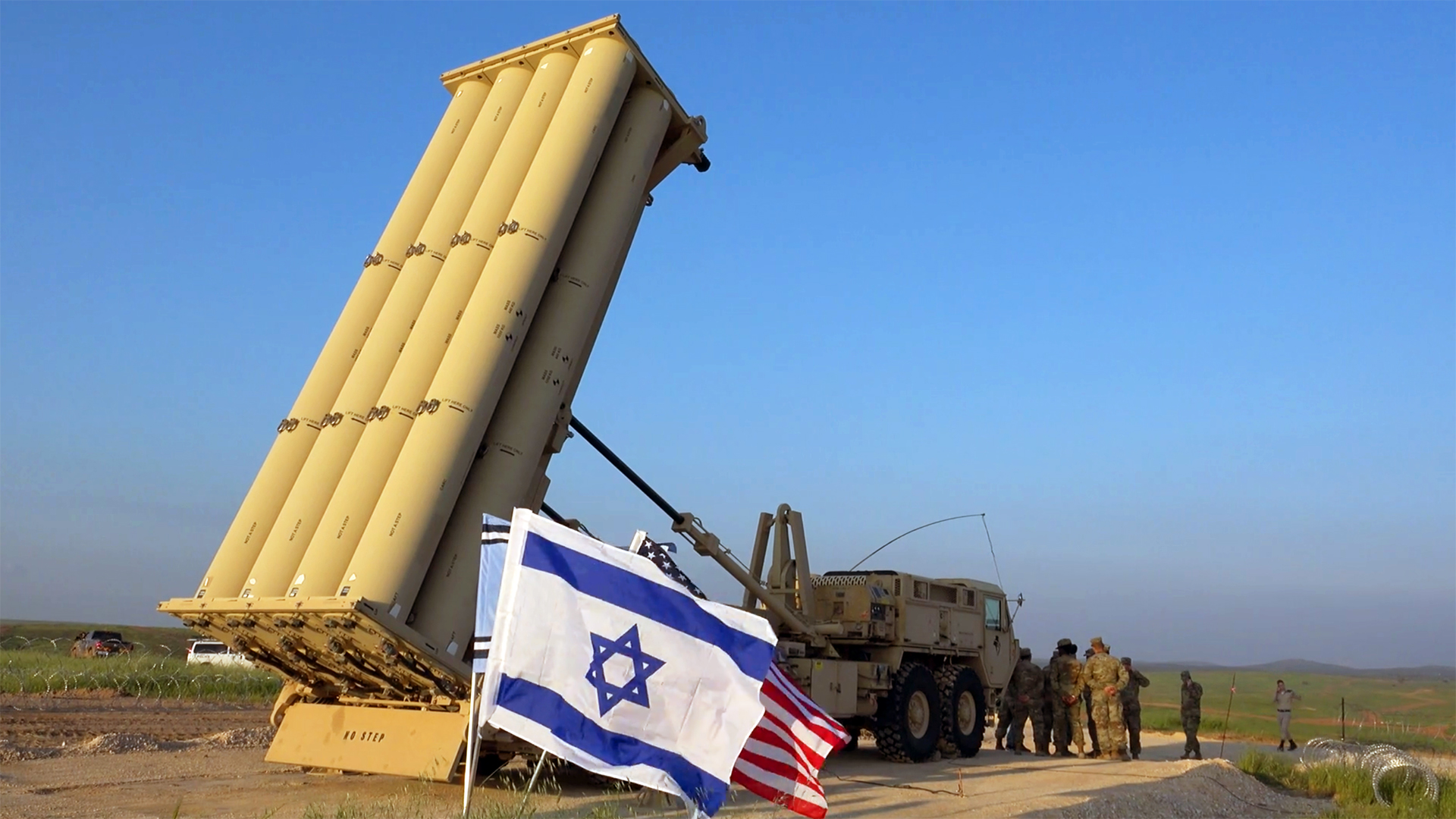One of America’s prized Terminal High-Altitude Area Defense (THAAD) batteries fired an interceptor in combat for the first time Thursday. The system, forward-deployed in Israel, was employed against an incoming medium-range ballistic missile (MRBM) fired by the Iran-backed Houthi rebels in Yemen, a U.S. military official told TWZ. The official added that it was unclear as of Friday if the U.S. interceptor or an Israeli one actually took out the missile. A THAAD battery belonging to the United Arab Emirates (UAE) scored the system’s first kill overall in 2022, as you can read more about here.
Video appeared online purportedly showing the U.S. THAAD interceptor’s launch in Israel earlier today. A voice was heard saying he had spent “18 years waiting for this,” a potential reference to the system’s age, as the U.S. Army stood up its first THAAD battery in 2008, after it was developed beginning in the early 1990s.
The THAAD battery and about 100 soldiers were deployed to Israel in October to bolster Israel’s defenses ahead of an expected Israeli retaliation for Tehran’s massive missile barrage earlier that month. A counter-attack from Iran never came to fruition, but the battery has stayed in place.
Houthi rebels have launched sporadic missile barrages at Israel for months, including while Israel was conducting airstrikes on multiple targets in Yemen during the early hours of Dec. 19.

On Friday, the Yemeni rebel group said it had launched a missile at Israel’s Ben Gurion Airport and also targeted Tel Aviv with a drone attack, all in retaliation for recent Israeli strikes on Sanaa International Airport, the Guardian reported. The Israel Defense Forces (IDF) said the ballistic missile was intercepted before it reached Israeli airspace. Still, residents in central Israel were ordered into shelters for fear of falling debris, the publication noted, adding that there were no reports in Israel of hostile drones over Tel Aviv.
The exact configuration of the THAAD battery currently in Israel is unclear, but a unit of this kind can include up to nine transporter-erector-launchers, each carrying eight interceptors, a long-range AN/TPY-2 X-band radar, a mobile fire control and command and control center, and various supporting equipment. Additional interceptors would be available to reload the launchers during a combat deployment, as well. It is a terminal missile defense system, meaning it takes out short-, medium- and intermediate-range ballistic missiles in the final stages of flight as they careen down through the atmosphere to their final targeted destinations.

For Israel, the THAAD sits at the top end of air defense systems in the country capable of terminal phase missile defense, which also includes David’s Sling and the Arrow 2 system. Israel recently retired its Patriot surface-to-air missile batteries, which had terminal missile defense capabilities. The land-based terminal phase intercept capability can be augmented by positioning U.S. Aegis-equipped surface combatants loaded with SM-6 missiles off the Israeli coast. Israel also has a robust mid-course intercept capability in the form of the Arrow 3 system and the same U.S. Navy ships loaded with SM-3s can also provide this capability.
The U.S. Army’s seven THAAD batteries have seen multiple short and long-standing deployments in the past. In addition to the one presently in Israel, two more of the units are currently forward-deployed, one in Guam and one in South Korea.
While Thursday’s intercept was the first time the U.S. Army had fired the system to defeat an incoming threat, as we noted earlier, the UAE used its THAAD system to bring down a Houthi ballistic missile that was targeting an oil facility near Al Dhafra Air Base, which was hosting U.S. and French forces in addition to Emirati personnel when the attack took place in January 2022. Go here to read TWZ‘s past reporting on that intercept.

The deployment this past October was not the first time a THAAD had been sent to Israel, either. The U.S. Army sent the system there in 2019 for an exercise, part of a Pentagon effort to test quickly deploying capabilities, while keeping adversaries from having too much foreknowledge about U.S. military plans, TWZ reported at the time.
The U.S. Army has maintained a long-range AN/TPY-2 X-band radar at Site 512, a so-called “cooperative security location” in Israel’s Negev Desert, since 2012, to bolster Israeli and U.S. missile defenses. The service also started manning a location known as Site 883 in 2017 at Israel’s Bislach Air Base, also in the Negev, seemingly to help streamline the flow of critical data from Site 512, another sign of America’s burgeoning air and missile defense capability in Israel before the current conflict erupted.
While Thursday’s intercept marks a THAAD milestone for the U.S. Army, it once again highlights strains in the service’s air defense systems and the soldiers who man them, finite capabilities that are increasingly deployed around the world. TWZ investigated the issue in-depth in 2023, and you can read that coverage here.
Demand within the U.S. military for advanced air defense systems, including THAAD, and the interceptors that go with them has only increased since then. Obligations in the Middle East, including to help defend Israel, as well as in Europe, particularly to Ukraine, have been important driving factors. Growing concerns about Chinese military threats in the Pacific have also prompted new air and missile defense needs.
Army Secretary Christine Wormuth acknowledged the stressors being placed on air defense batteries at the time of the THAAD deployment to Israel. Wormuth noted that “the air defense artillery community is the most stressed,” and said that such units have the highest operational tempo.
To mitigate that, Wormuth said the service was trying to modernize its integrated and missile defenses to create more capacity. That in part involves integrating the Patriot battery’s new Lower Tier Air and Missile Defense Sensor (LTAMDS) into the Army’s Integrated Battle Command System (IBCS) network. Wormuth said that integration would “greatly increase the capacity of the existing Patriot force that we have, and that will help reduce some of the stress on our soldiers.”

TWZ has previously broken down what LTAMDS brings to the table:
“LTAMDS is designed to provide higher-fidelity sensing capability at much further distances and process a wider array of data more quickly than the Patriot’s current radar. It can also offer 360-degree coverage, which the current system cannot. The IBCS connects various sensors to effectors like, gun systems, lasers, missile systems, and electronic warfare capabilities and combines all this data on the entire air defense situation into a single actionable ‘picture’ for operators. The combination is meant to give air defenders a much greater ability to better react to and if necessary shoot down a multitude of threats at once.”
Still, while this force multiplying new technology will certainly help, physically more missile batteries are also a critical part of the solution but just how much investment will be poured into doing so remains to be seen.
Other Army lines of effort involve being “as choosy as we can about what we take on,” so as to minimize stress on the force, Wormuth said.
Update: Dec. 30, 1:32 PM Eastern –
A U.S. government official confirmed to The War Zone Monday that a THAAD successfully intercepted a Houthi medium-range ballistic missile (MRBM) fired at Israel last week. Fox News was the first to report a successful interception.
Contact the author: geoff@twz.com
